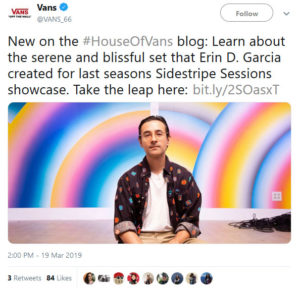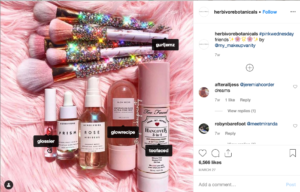
How to Create A Social Media Style Guide [Plus An Amazing Template]
With billions of active social media users and at least 21 social media sites to consider for your brand, you’re facing a lot of competition for attention. Knowing who you want to reach and what visual and verbal nuances resonate with them allows you to filter through a lot of the noise. It also naturally aligns marketing decisions with your brand and goals. If you already have a brand style guide, that’s a great first step! Taking it a step further by adding a social media style guide component adds action to your brand guide. It’s too easy to create standards, tuck them away, and forget about them. A social media style guide ensures that you and your team bring your style guide to life in your day-to-day communications. Some other benefits of having a social media style guide in place include:
- Aligning everyone in your company around the tone, format, style, cadence, and imagery that best fits your brand across channels
- Setting expectations and standards for quality content
- Acting as an extension of your editorial style guide or brand style guide
A word of warning before you begin, if you don’t have the resources to keep strategy aligned with tactics, consider hiring someone to help or refrain from social media marketing until you do. Engaging in social media tactics without a well-researched strategy to back them up can damage your brand far more than help it.
Before You Begin: Get Organized
Before diving into how to create a social media style guide, I suggest getting organized. Create a brand assets folder as a central place to house all of the different documents, images, videos, templates, etc. you’ll create. Maintain all these components in a cloud-based storage platform like Google Drive or Dropbox so you can easily collaborate with your team or share with who you’ve hired to help. You can even take it a step further by creating a taxonomy to include in your style guide so anyone can easily search for an asset.
Below is a step-by-step guide to creating a social media style guide, as well as a download of the template we use. This could serve as a starting point for your own style guide, however, you should customize the steps to fit your needs and goals. If you find part of this doesn’t serve your organization, leave it out. If you think we missed anything, please let us know in the comments below the post.
These sections may change over time. It’s ok to think of any content strategy document as a living document that evolves as your brand does.
STEP 1: Determine Your Goals + Define Your Purpose
The first step in crafting your social media style guide is to figure out the why behind your social media presence.
What are your goals on social media? Is it to bring in new business? Help customers with your product? Network with industry insiders?
It’ll most likely be a combination of things. It’s ok to pick multiple goals, just don’t confuse your followers with random or inconsistent messages.
Here are some goals to choose from:
- Engage an existing audience around your brand or related issue to build loyalty
- Educate potential or existing customers on a topic core to your brand
- Inform potential customers on how your brand will help solve their pain points
- Enable your customers to succeed at what they came to do
- Entertain your audience so they engage and pay attention
- Delight your users by having next level customer service
- Empower your audience to make the best choices for them
- Amplify an issue your brand and its audience stand behind
Write a short paragraph defining these as they relate to you and how you’ll bring them to life through the content you share.
For instance, you may want to educate people without patronizing or confusing them and empower and them to learn to become better marketers.
Something like this works:
“Our ( insert your brand ) main purpose on social media is to build a community around our luxurious bath products and inspire people to invest in this self-care ritual. This is accomplished by increasing our social media presence, telling the story of our brand, bringing our ideal customer on a journey, educating them around bath rituals and converting them on our (insert your brand) products. Along the way, we plan to grow the newsletter subscriber list, increase average order value, and improve repeat purchase metrics.“
If you already have your brand style guide, your voice and tone documentation can help define which goals you choose. If you haven’t yet worked on a style guide, you should probably tackle that before you embark on social media marketing. MailChimp publishes their writing goals and principles, which could be a helpful resource if you’re just getting started with style guides. Check those out here.
STEP 2: Develop a Persona or Personas
Personas are an essential part of your content strategy. They define who you want to speak to in your content. We engage with our personas not just in our website copy but when we post on social media as well.
Have at least one persona featuring your ideal customer characteristics – for example, “CTO Charlie” or “Marketing Manager Matt.” These examples are B2B personas, there are also guides available for creating B2C personas that delve into more personal demographics and psychographics.
Bring your personas to life. In a B2B persona, focus on solving work-related issues and aligning your brand with the solutions your persona might be experiencing or needing. These concerns and how your persona thinks about them should drive your messaging and channel choices.
Do your research. Once you have an idea of who your persona is, find examples of them in real life. Look at who they follow, what they read, where they find information relevant to your offering. Ask them what their interests and true pain points are. Using this intel, compile a list of influencers, publications, and categories of interest to discuss in relevant groups or communities.
You already know how your product or service solves their pain points. Your personas will help you determine how to best speak to your audience in an empathetic and intentional way.
STEP 3: Identify Your Engagement Style
There are several ways to approach your engagement with followers on social media. Please note that engaging with followers will not always be easy or enjoyable.
You may come across angry customers, negative comments, backlash for political incorrectness, etc. We see top companies dip themselves into hot water for these incidents all the time.
Remember this?

Have an established plan on how to handle each of these situations as part of your style guide. Remember, sometimes you might just have to accept that you messed up. Take responsibility, apologize, and move on.
The way in which you handle your engagement style truly depends on your brand and what message you want to convey.
How long will it take you to respond to comments? What are you going to do to engage new followers? Will you reply to every comment that comes your way? Will you thank people for sharing/liking your content?
These are all questions that can be addressed in your social media style guide in the Do’s and Don’ts section described below. Here are other elements that will define your engagement style.
Voice and Tone
The way you communicate online will help determine if and how your audience remembers you. Your brand’s personality will shine through your voice and tone.
You might be wondering what’s the difference between voice and tone? Let’s look at the explanation Mailchimp provides:
Think of it this way: You have the same voice all the time, but your tone changes. You might use one tone when you’re out to dinner with your closest friends, and a different tone when you’re in a meeting with your boss.
Your tone also changes depending on the emotional state of the person you’re addressing. You wouldn’t want to use the same tone of voice with someone who’s scared or upset as you would with someone who’s laughing.
Social media voice should stay consistent across all your channels, but depending on the situation, your tone will change. Think of your social media voice as what defines your brand’s personality and tone as the style in which you choose to communicate on certain channels or topics.
Some Examples:
Van’s voice on Twitter is direct and to-the-point but their tone is warm and fun. They do “sell” in their voice but in a respectful way that doesn’t waste your time. Their voice is all about their brand, their tone is more about their audience. They focus on sharing product updates or quality content:


Both Thrive Market and charity:water are big on educating their audiences on topics related to their brands: health, wellness, global poverty and water issues. In this Instagram post, Thrive Market maintains their empathetic voice while also adding urgency to their tone due to the serious nature of the topic:

Compare that to their tone in a video post promoting a new recipe:

P.S. Be sure to note their use of hashtags. 😉
Formatting
You wouldn’t post in the same format on Twitter as you would LinkedIn because each channel has its own language and culture. LinkedIn is more about B2B communications and therefore the language is authoritative, professional, and not casual like Snapchat.
Here is a breakdown of some norms for each channel:
Twitter:
- More conversational
- Utilizing trending hashtags
- Stick to 140 characters
- Consider including an image and link
- Change Post or Page Title to be directly relevant
- Retweets of your industry thought leaders “as-is” ( make sure you ‘@” them so they see you mentioned them )
- Use your social media tool’s link shortening to conserve characters
LinkedIn:
- A polished tone of voice
- Professional language signifying a thought leader
- Don’t just brag about your professional accomplishments or people will tune out
- Always include an image and link
- No hashtags
- Share industry news and/or insights
Facebook:
- Be inspirational, that type of post works well here
- A good place to straight SELL your product or service
- Ask questions to your audience, be conversational
- Try video here, the algorithm loves it but be sure to upload your file directly
- Always include image and link
- No hashtags
- Clean all URL parameters from third-party posts, use an existing image from an article
Instagram:
- Striking imagery, if you don’t have any, or plan to produce them, don’t bother with this channel
- Use emojis!
- Video has the highest engagement rate
- Instagram stories will keep your content at the top of everyone’s feed
- Create polls. They’re easier than contests and helps boost engagement!
- You can only add a link in your bio – so make that bio shine!
- A great place to truly connect and get to know your audience
Snapchat:
-
- Very conversational and informal
- Animate your text!
- Use those giphy stickers!
- Engaging videos and photos showcasing your brand’s culture
- Create your brand lens!
- Showcase the unique personality of your brand and company culture
Consistency
The brand’s messaging and voice should have consistency. An example of consistency on Instagram for a wellness brand could be always posting a new health tip on Wednesday to take advantage of the hashtag #wellnesswednesday. People begin to expect it in their inbox on a certain day/time. This is oftentimes to be determined after testing and the editorial calendar is the place where you define your terms and optimal frequency.
Cadence
Cadence refers to how many times a day, week, or month you post on each social media channel. It also refers to what times of day you post.
You can gather insights on the best times of day to post using Google Analytics and the specific analytics of the social platform and cross-reference with your social sharing software, like Buffer or Sked Social an awesome Instagram scheduler, to best determine optimized times. You could also cheat a little.
I suggest using an editorial calendar to set the frequency at which you’ll post content and what channels to focus on and when. Do you want to send out 15 tweets a day? Or two Instagram images per week? How many posts per channel do you want to push out to your audience? Whatever you choose, just be sure you’re consistent and hold yourself accountable using your calendar.
STEP 3: Create Unity Around Your Tactics
Your style guide is an excellent place to align your team around social media tactics that match up with your goals, personas, and voice. Below are three tactics to consider how you and your team will approach executing your social media strategy.
Mentions
Mentioning or tagging people in your social media posts let’s them know it’s there so they can share with their audience. But it also builds a sense of community and adds your content into the conversation that is already happening. Your post becomes about more than just you, it highlights others as well. And typically, the way algorithms work, it will be presented to their audience when they “like” it, even if they don’t share it.
Influencers, for example, also often tag products or brands they use. If you want to highlight your favorite beauty products, you could tag those brands so that they see it, creating an opportunity to connect.
Here’s an example of how Herbivore Botanicals tagged Glossier and other beauty influencers. This multi-brand strategy gets new products in front of audiences who will most likely follow and buy from them at some point.

Links
Including a link to draw potential customers into your marketing funnel is a no-brainer, but link shortening methods aren’t always applied. We recommend using a campaign URL builder in your profiles to track metrics for each of your channels and using the auto-generated link-shortener of your social media scheduling tool, like Buffer, or Sked Social.
Imagery
Your social media depends heavily on images and videos. Content with images receives 94 percent more views than content without images. Which means that every post should be accompanied by an image. Include a social media image size cheat sheet as part of your style guide so you have image sizes for each channel handy.
Add standards and style section to your guide defining what type of images should be posted, what color scheme you want to be executed, any formatting guidelines, etc. Elements to consider are how high-res or polished you want photos to be or if lo-fi and gritty is more your thing. Also, if memes and gifs are ok or if you want your content to be more serious.
Hashtags & Keywords
Using trending hashtags and keywords will help increase your impressions and engagement rates by creating visibility in search results. You need to stay on the pulse with the trending keywords and hashtags and jump in on the conversation if one aligns with your brand.
Be consistent with your use of hashtags and keywords across all social channels to increase the discoverability of your content.
For example, if a trending Twitter conversation and accompanying hashtag is #outdooradventure and you’re a bicycle company promoting people to spend more time outdoors biking, then you have a great opportunity to jump in on that hashtag, partake in the conversation, and then yield more followers and business from people who are following that trend. You have an interested audience ready to buy and follow right at the click of your keyboard. #winning
This next series of steps serve as examples to help you compare “good” social media to “bad” social media and provides some quick do’s and don’ts you should be aware of.
Social Media Do’s & Don’ts
The do’s and don’ts of your social media posting is determined by your company culture and how your audience expects to be addressed. For example, a “do” might be to pin the newest branded content at the top of your Facebook page every week. A “don’t” might be to avoid commenting on politics or religion.
Essentially, you’re just laying the ground rules in this section of the guide. If multiple people have access to your account, mistakes get made. Make sure it’s clear what to do and what not to do on your channels.
Final Thoughts
Having a social media style guide on deck will be an asset to your business and brand. Once you establish your style guide, don’t stop there. Make sure you work on solidifying your brand imagery, enforcing your editorial calendar dates, and continuously improving your personas. All strategy is a work in progress – never stop learning and evolving!
Feeling overwhelmed? We can help you build a style guide to fit your business, brand, and goals. Contact us today and let us know where you might be stuck or how we can help you evolve your brand.
If you have enjoyed this post, please take a moment to share it.
Ready to dive in on your own?


